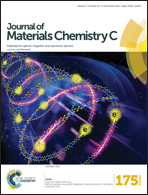Epitaxial growth of two-dimensional SnSe2/MoS2 misfit heterostructures†
Abstract
van der Waals (vdWs) heterostructures, obtained by vertically stacking two-dimensional layered materials upon each other, appear particularly promising for future atomically thin electronic and optoelectronic devices and attract a great deal of attention due to their diverse functionalities. Chemical routes to construct vdWs heterostructures offer the prospect of both high yield and uniformity which is the foundation for their application in the semiconductor industry in the future. Here we demonstrate the growth of two-dimensional SnSe2/MoS2 heterostructures with a large lattice misfit via a two-step chemical vapor deposition method. The bottom MoS2 monolayers can be partially or fully covered with single-crystalline SnSe2 monolayers by controlling the growth conditions. The as-grown heterostructures are characterized by using optical microscopy, atomic force microscopy, scanning electron microscopy, transmission electron microscopy, Raman and photoluminescence spectroscopies. The results indicate that the heterostructures display the vdWs epitaxial feature, that is, the vertically stacked SnSe2/MoS2 heterostructures with well-aligned lattice orientation. The interlayer coupling interaction and charge separation are also observed in the heterostructures by Raman and photoluminescence spectroscopies. We believe that our results could be helpful for understanding the fundamental physics of atomically thin vdWs heterostructures, and such heterostructures may have potential applications in novel electronics and optoelectronics.


 Please wait while we load your content...
Please wait while we load your content...